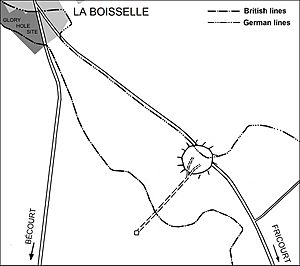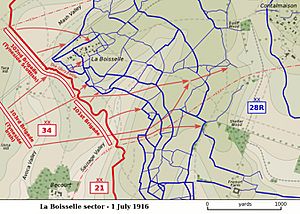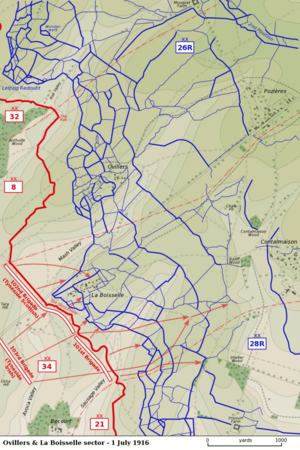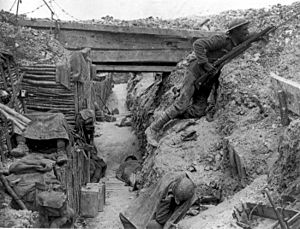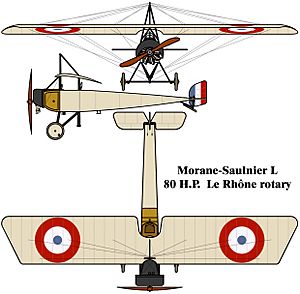Capture of La Boisselle facts for kids
Quick facts for kids Capture of La Boisselle |
|||||||
|---|---|---|---|---|---|---|---|
| Part of the Battle of the Somme, First World War | |||||||
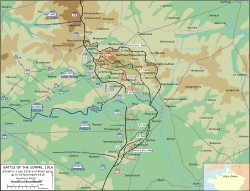 Battle of the Somme 1 July – 18 November 1916 |
|||||||
|
|||||||
| Belligerents | |||||||
| Commanders and leaders | |||||||
| Douglas Haig | General Erich von Falkenhayn | ||||||
| Strength | |||||||
| 2 divisions | 3 regiments | ||||||
| Casualties and losses | |||||||
| 9,860 | 1,601 (incomplete) | ||||||
The Capture of La Boisselle was an important event during the Battle of Albert, which was the start of the much larger Battle of the Somme in World War I. This battle took place from July 1 to July 6, 1916. La Boisselle is a small village in northern France, about 22 miles (35 km) northeast of Amiens. It was part of the village of Ovillers-la-Boisselle.
On July 1, 1916, the first day on the Somme, British troops from the 34th Division attacked La Boisselle. However, their bombs had not destroyed the strong German underground shelters. Also, a German listening post had overheard a British phone call the day before, giving away the attack plan. The British suffered over 11,000 casualties and couldn't capture La Boisselle or Ovillers. They only managed to get small footholds nearby.
The 103rd (Tyneside Irish) Brigade faced heavy artillery and machine-gun fire, losing 70 percent of their soldiers before even reaching the German lines. The 19th (Western) Division was quickly sent in to continue the attack. Most of La Boisselle was captured by July 4, and the entire operation was finished by July 6.
Background to the Battle
War in 1914 and 1915
La Boisselle became a key location in the war as early as September 1914. French and German forces fought fiercely for control of the area. The Germans wanted to push west along the Somme valley to Amiens. However, the French stopped their advance around La Boisselle.
Fighting continued with many small attacks and counter-attacks. Both sides used mines, digging tunnels under enemy lines to plant explosives. This created huge craters and made the ground very dangerous. The Germans also built strong defenses, including deep underground shelters called minierte Stollen, which were 20 to 30 feet (6 to 9 m) deep and could hold 25 men. They also laid thick barbed wire fences. These strong defenses made it very hard for attacking troops to advance.
By 1915, the Germans had built a very strong defensive system. They had multiple lines of trenches, wide barbed wire obstacles, and deep dugouts. This was designed to hold the front line with fewer soldiers, as many German troops were fighting elsewhere.
Preparing for 1916
In 1916, the Germans continued to improve their defenses. They added a third defensive line further back. They also set up a good telephone system, with lines buried 6 feet (1.8 m) deep, to connect their front lines with their artillery.
However, the German defenses had some weaknesses. Their front trenches were on a forward slope, which meant British observers could easily see them. Also, many German troops were crowded near the front line, making them easy targets for artillery attacks.
By mid-June, the Germans knew a big attack was coming on the Somme front. British air observers saw more railway activity and new digging, and spies reported an upcoming offensive. On June 24, a British prisoner even revealed that a five-day bombing would start on June 26. Despite this, the Germans did not send many extra troops to the area until July 1.
Getting Ready for the Attack
British Plans
The British III Corps was in charge of the attack on La Boisselle. Their front line was on a low ridge, giving their artillery observers a clear view of the German positions. The German trenches were easy to spot because they were lined with white chalk. The area between the two armies, called no man's land, was 50 to 800 yards (45 to 730 m) wide. The narrowest part was at La Boisselle, known as the "Glory Hole."
The British had many heavy guns and howitzers ready. However, they faced problems with their ammunition; some shells exploded too early, hurting their own gunners, and many didn't explode at all. Because of these issues, and because German soldiers were still firing from La Boisselle, the British decided to use Stokes mortars to bombard the village.
Huge Mines: Lochnagar and Y Sap
British engineers, called sappers, dug secret tunnels under the German lines. They worked quietly, using bayonets with special handles and even working barefoot to avoid making noise. They carefully removed flints from the chalk and stored the dirt in sandbags.
The Lochnagar tunnel was about 1,030 feet (314 m) long. The sappers placed a massive amount of explosives, 60,000 pounds (27,216 kg) of Ammonal, in two charges deep underground. Just north of the village, another mine, Y Sap, was loaded with 40,600 pounds (18,416 kg) of Ammonal. Two smaller mines were also planted. These mines were meant to destroy German positions and create large craters that would block German fire.
British Attack Plan
The British planned for their heavy artillery to move its fire in stages, or "lifts," from one German defense line to the next. The infantry would follow closely behind a moving wall of artillery fire, called a barrage. This barrage was supposed to move slowly, clearing the way for the soldiers.
The 34th Division, made up of "Pals battalions" (groups of friends who joined up together), was given the tough task of capturing the German positions around La Boisselle. They had to capture a fortified village and six German trench lines, advancing about 2 miles (3.2 km). The plan was for the division to attack in waves, with four columns of soldiers. La Boisselle itself was not to be attacked directly at first. Instead, bombing parties would attack from the sides as the main columns passed by.
Many of the soldiers in the 34th Division were coal miners before the war. They used their digging skills to create a complex network of underground tunnels in Tara hill to shelter the battalions before the attack.
German Defenses
The German defenses at La Boisselle were very strong. They had four main strong points in the southern area, including "Helgoland" (called Sausage Redoubt by the British) and "Schwabenhöhe" (Swabian Heights, or Scots Redoubt). The German front line was held by two battalions of Reserve Infantry Regiment 110, with a third battalion in reserve. The nearby village of Ovillers was also heavily fortified.
The German positions were on a forward slope, which meant the British could see them clearly. However, the "Glory Hole" area, a field of craters west of La Boisselle, was hidden from view.
The Battle Begins
July 1: The First Day
At 7:30 a.m. on July 1, the British infantry of the 34th Division began their attack. Within ten minutes, 80 percent of the soldiers in the leading battalions were casualties. German machine-guns, hidden behind the front line, opened fire as soon as the British bombing stopped. Bullets swept across no man's land, which was 200 to 800 yards (180 to 730 m) wide. When the leading groups were stopped, the rest of the soldiers bunched up, becoming easy targets.
The right-hand column of British troops managed to capture the German front trench. However, German fire from Sausage Valley and La Boisselle forced them off course. Some soldiers advanced about 1 mile (1.6 km) before realizing they were in the wrong area. They had accidentally separated two German infantry companies. The Germans counter-attacked, forcing the British back.
The second British column waited five minutes after the main attack to avoid debris from the Lochnagar mine. The mine exploded exactly on time at 7:28 a.m., creating a huge crater 270 feet (82 m) wide and 210 feet (64 m) deep. It killed most of the German 5th Company. However, the delay meant the Germans had more time to get ready. Machine-gun fire from Sausage Redoubt and La Boisselle hit the British troops before they even crossed no man's land. Only a few isolated groups made it across. Some soldiers who reached Sausage Redoubt were burned by German flamethrowers. Many survivors took cover in the Lochnagar mine crater.
On the left flank, the 102nd Brigade advanced as the Lochnagar mine exploded. They had only 200 yards (180 m) to cross and managed to overrun the German position called Schwabenhöhe. However, their right side was not supported. German machine-gunners in La Boisselle fired on them, causing many casualties. Despite this, some survivors reached the first intermediate line. The fourth column, attacking north of La Boisselle, was also hit by heavy machine-gun fire from La Boisselle and Ovillers. Most of these troops were shot down in no man's land.
Thick smoke and dust made it hard for British observers to see what was happening. At first, they believed exaggerated reports of success. No troops were left in reserve to continue the attack. By nightfall, two communication trenches were dug across no man's land, allowing supplies to reach the few British footholds in the German defenses.
July 2: Continuing the Fight
By dawn, the 9th Cheshires had arrived and relieved the exhausted 34th Division troops. The Germans ordered their Reserve Infantry Regiment 110 to retreat through La Boisselle, but Ovillers was to be held at all costs. British companies advanced across 500 yards (457 m) of no man's land and bombed their way into Sausage Redoubt, taking 58 prisoners.
The British 58th Brigade attacked La Boisselle. They used a trick: they bombed Ovillers to make the Germans think the main attack was there. This worked, and German artillery fired on Ovillers instead of La Boisselle. The British attacked the village directly and captured the German front line trench with few casualties. As the Germans recovered, fighting became tougher. The British systematically searched for and bombed German underground shelters. By 9:00 p.m., they occupied the west end of the village and dug in near the church.
July 3: Pushing Forward
During an attack on Ovillers, a British company accidentally strayed towards La Boisselle and trapped 220 German soldiers, who surrendered. The British 57th and 58th Brigades attacked again, trying to advance beyond the village. Through bombing and hand-to-hand fighting, the British slowly drove the remaining German troops out of the village, taking 123 prisoners.
The German underground shelters in the village had survived the bombings. When the British tried to signal their success with flares, German artillery bombed the village, followed by a counter-attack. This forced the British back from the east end of the village. Reinforcements arrived, and a new line was set up through the church ruins. The 34th Division, which had suffered 6,811 casualties from July 1 to 5, was relieved by the 23rd Division.
July 4–6: Final Capture
Rain fell on the night of July 3/4, turning the ground into deep mud. This made movement very difficult. On July 4, the 56th Brigade of the 19th Division attacked La Boisselle again. They bombed their way up trenches, supported by machine-guns and Stokes mortars. The Germans resisted strongly, but by 2:30 p.m., all but some ruins at the north end of the village had been captured.
The 23rd Division also attacked, and fighting continued fiercely. A German counter-attack forced the British back from Horseshoe Trench, but later in the day, the British attacked again and captured Horseshoe Trench and Lincoln Redoubt. The 19th Division attacked the east side of La Boisselle but was pushed back. Reinforcements arrived for both sides, and neither could advance further. During the night, the 12th Division relieved the 57th Brigade at La Boisselle. On July 6, the British attacked again and finally succeeded, defeating three German counter-attacks.
Air Operations
The explosion of the Lochnagar and Y Sap mines was seen from the air by C.A. Lewis, a pilot from 3 Squadron. He described a "tremendous and magnificent column" of earth rising almost 4,000 feet (1,219 m) into the sky, followed by a cone of dust and debris. He then saw the "two white eyes of the craters."
British aircraft also flew over the battle area, reporting on troop movements and positions. On July 3, air observers noted flares lit in the village, which helped them map where British infantry had reached.
Aftermath
Casualties
On July 1, the 34th Division suffered the most casualties of all British divisions, losing 6,380 men. For example, the 15th Royal Scots lost 513 men, and the Grimsby Chums lost 477 men. The 19th Division, which helped capture La Boisselle, lost about 3,500 soldiers. The German Reserve Infantry Regiment 110 lost 1,251 men from July 1 to 3.
Later Events
After the Battle of Albert (July 1–13), La Boisselle became a quieter area. However, the village was recaptured by the Germans on March 25, 1918, during their Spring Offensive, called Operation Michael. British air reconnaissance saw the British defense collapsing, and their planes worked hard to disrupt the German advance.
La Boisselle was finally recaptured for the last time on August 26, 1918, by the 38th (Welsh) Division during the Second Battle of Bapaume.
Images for kids
See also
- Capture of Ovillers
- Ovillers-la-Boisselle in World War I


